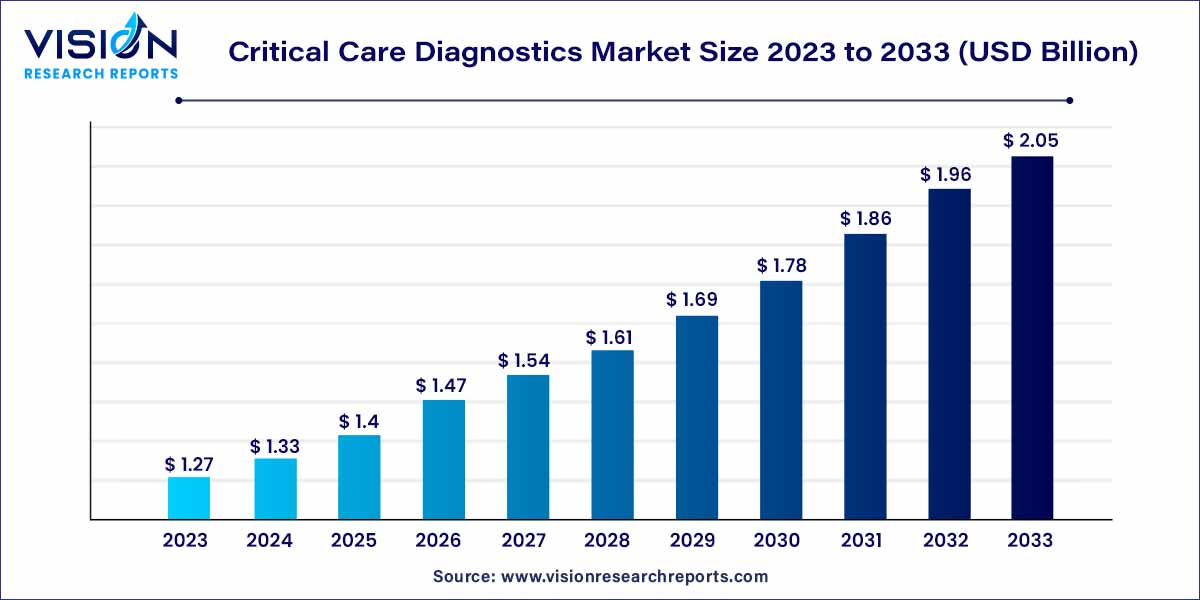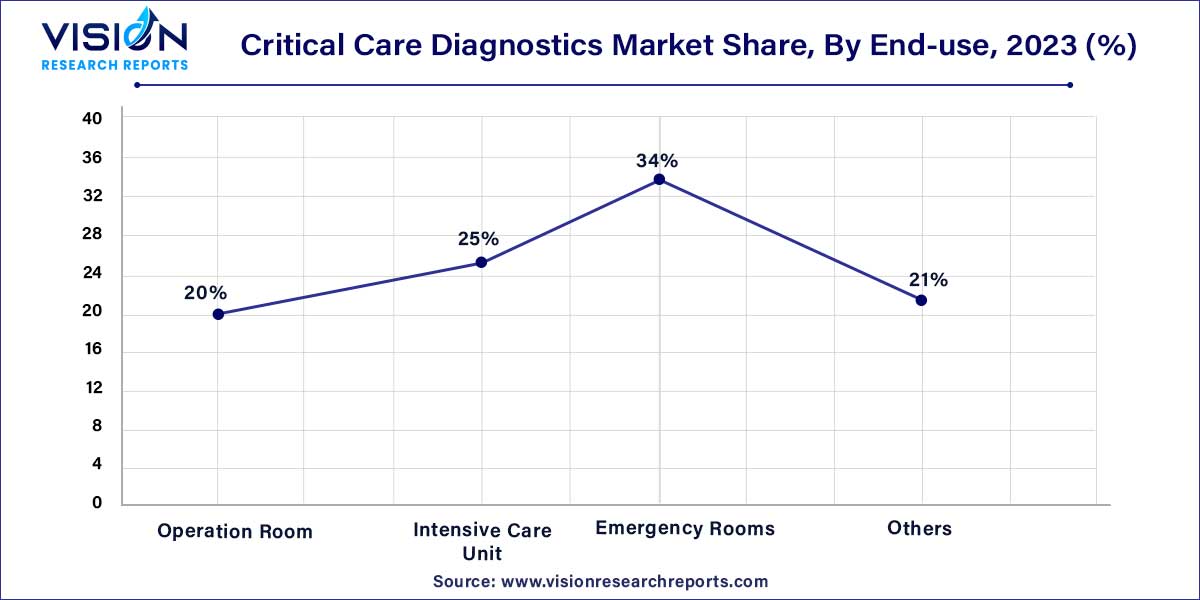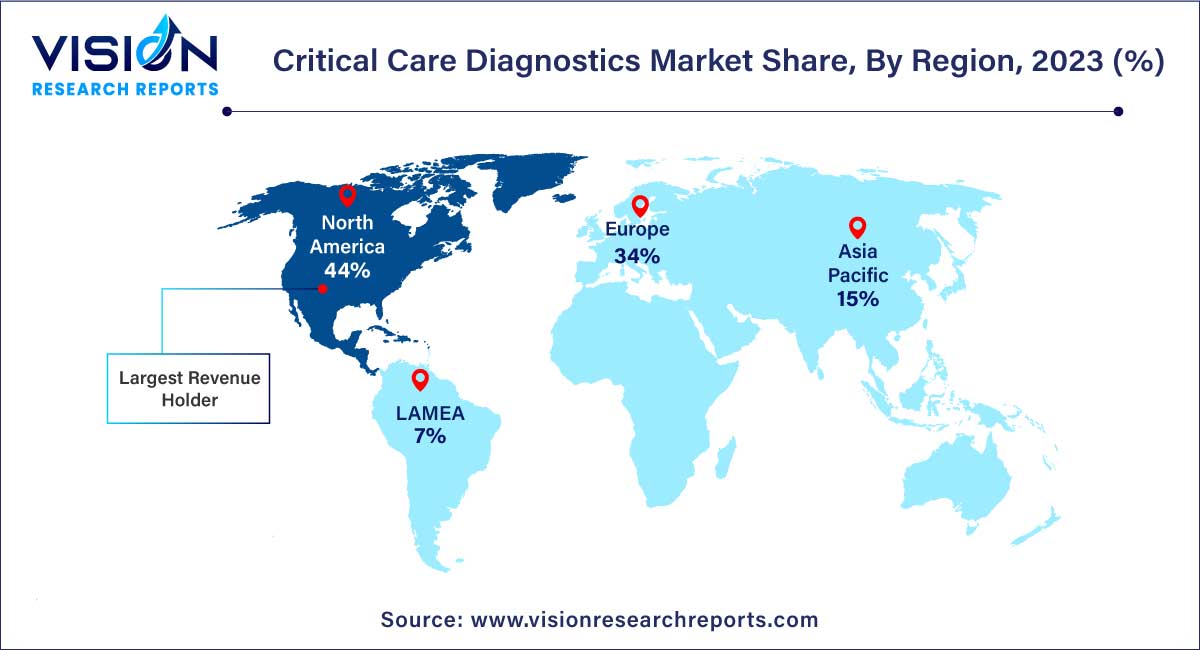The global critical care diagnostics market size was estimated at around USD 1.27 billion in 2023 and it is projected to hit around USD 2.05 billion by 2033, growing at a CAGR of 4.92% from 2024 to 2033. The growing incidence of chronic illnesses, such as cardiovascular diseases, respiratory disorders, and cancer, has spurred the need for critical care diagnostics.

The critical care diagnostics market is a dynamic sector within the broader healthcare industry, characterized by its focus on providing rapid and precise diagnostic solutions for critically ill patients. This segment has gained increasing prominence due to its pivotal role in facilitating timely and informed medical interventions.
The growth of the critical care diagnostics market is propelled by a confluence of factors that collectively contribute to its expanding trajectory. One significant driver is the continual evolution of diagnostic technologies, ushering in rapid and more accurate methods for assessing critically ill patients. The rising prevalence of life-threatening conditions, coupled with an increasing demand for prompt and precise diagnostic solutions, further stimulates market growth. The advent of Point-of-Care Testing (POCT) has emerged as a transformative trend, enabling healthcare professionals to conduct on-the-spot diagnostics, thereby expediting decision-making processes. Additionally, the integration of Artificial Intelligence (AI) has elevated the diagnostic landscape, fostering more nuanced and data-driven patient assessments. While the market is on an upward trajectory, challenges such as regulatory complexities and the necessity for substantial research and development investments underscore the need for strategic navigation. In navigating these challenges, the critical care diagnostics market is positioned for sustained growth, driven by a commitment to technological innovation, improved patient outcomes, and enhanced healthcare efficiency.
| Report Coverage | Details |
| Market Revenue by 2033 | USD 2.05 billion |
| Growth Rate from 2024 to 2033 | CAGR of 4.92% |
| Revenue Share of North America in 2023 | 44% |
| CAGR of Asia Pacific from 2024 to 2033 | 6.93% |
| Base Year | 2023 |
| Forecast Period | 2024 to 2033 |
| Market Analysis (Terms Used) | Value (US$ Million/Billion) or (Volume/Units) |
The market is categorized into routine and special chemistry, flow cytometry, hematology, immunoproteins, microbial and infectious diseases, coagulation, and others. The immunoproteins segment dominated the market with the largest revenue share of 37% in 2023. Immunoproteins are amino acids that function in the immune system, a system of biological functions that guards an organism against disease. The immune system can detect and respond to various pathogens, such as bacteria, viruses, parasites, fungi, cancer cells, and foreign objects. Immunoproteins are involved in both the innate immune system and the adaptive immune system of the immune system, and they can be classified into different types, such as antibodies, cytokines, complement proteins, and major histocompatibility complex proteins.
The microbial and infectious disease segment is expected to grow at the fastest CAGR of 5.53% over the forecast period. These diseases are caused by microorganisms such as bacteria, viruses, parasites, and fungi. Diseases such as HIV, flu, measles, and COVID-19 are examples of microbial and infectious diseases. The segment growth is majorly driven by factors, such as clinical chemistry, flow cytometry tests, and coagulation tests, among others. Moreover, microbiology, infectious tests, and immunoproteins assays are estimated to drive segment growth over the forecast period.
The hematology segment is expected to grow at a lucrative CAGR over the forecast period owing to constant innovative and advanced product launches by market players. For instance, in May 2023, Siemens Healthcare GmbH, a medical devices company based in Germany, announced the launch of two new innovative hematology analyzers: the Atellica HEMA 580 and 570 Analyzers. The analyzers provide user-friendly interfaces and seamless connectivity to multiple analyzers, enhancing workflow efficiency and rapid throughput. These analyzers are designed to eliminate obstacles in the laboratory workflow, enabling streamlined operations and accelerated processing of samples.
On the basis of end use, the market has been segmented into operation rooms, intensive care units, emergency rooms, and others. The emergency rooms segment led the market with the highest revenue share of 34% in 2023 and is also expected to grow at the fastest CAGR of 5.63% over the forecast period. This can be attributed to the prevalence of chronic diseases such as heart strokes, heart attacks, kidney failure, and a rise in mental issues such as anxiety, depression, and other disorders.

The intensive care unit segment is expected to grow at a lucrative CAGR during the forecast period owing to the increasing prevalence of chronic conditions in the U.S. According to the U.S. Department of Health & Human Services, the average ICU occupancy rate in the U.S. was 76.3% as of December 2022. This means that out of 79,271 staffed ICU beds in the country, 60,503 were occupied by patients, of which 12,345 were COVID-19 cases.
North America dominated the market with the largest revenue share of 44% in 2023, owing to better healthcare infrastructure, more healthcare spending, and better technological acceptance. According to America Medical Association, the U.S. spent USD 4.3 trillion on healthcare, which equates to USD 12,194 per capita. The overall health spending was around 18.3% of the GDP in the same year.

Asia Pacific is expected to grow at the fastest CAGR of 6.93% over the forecast period due to the high patient population, rising healthcare awareness, increasing investment in healthcare, and various government initiatives. Pneumonia is one of the largest infectious diseases which causes death in children globally. According to the World Health Organization (WHO), it accounts for 14% of deaths in children under five years, killing 740,180 children in 2019. Southern Asia and sub-Saharan Africa toll for the highest number of deaths in children due to pneumonia.
The increasing prevalence of diseases such as pneumonia in the Asia Pacific countries is one of the major factors driving the demand for diagnostics in critical care settings. In addition, various healthcare organizations are undertaking strategic activities such as innovative product and service launches to gain a competitive advantage, resulting in an increasing demand for critical care diagnostics. For instance, in August 2019, Brains Super Speciality Hospital, a provider of complete care for a wide range of health conditions specializing in neurosurgery and brain care, announced the launch of advanced operating suites at BR Life SSNMC Hospital. The operation theatre complex features dedicated operating rooms equipped with state-of-the-art technology to ensure the safety and efficacy of brain and spine surgeries. This complex comprises independent operating suites designed to meet the specific requirements of these specialized procedures. The operating theatre is versatile, facilitating both micro-surgery and simultaneous cerebrovascular intervention. This dual-purpose capability provides a sophisticated operating environment and includes a compact cerebral angiography suite for precise imaging during procedures.
By Type
By End-use
By Region
Chapter 1. Introduction
1.1. Research Objective
1.2. Scope of the Study
1.3. Definition
Chapter 2. Research Methodology
2.1. Research Approach
2.2. Data Sources
2.3. Assumptions & Limitations
Chapter 3. Executive Summary
3.1. Market Snapshot
Chapter 4. Market Variables and Scope
4.1. Introduction
4.2. Market Classification and Scope
4.3. Industry Value Chain Analysis
4.3.1. Raw Material Procurement Analysis
4.3.2. Sales and Distribution Channel Analysis
4.3.3. Downstream Buyer Analysis
Chapter 5. COVID 19 Impact on Critical Care Diagnostics Market
5.1. COVID-19 Landscape: Critical Care Diagnostics Industry Impact
5.2. COVID 19 - Impact Assessment for the Industry
5.3. COVID 19 Impact: Global Major Government Policy
5.4. Market Trends and Opportunities in the COVID-19 Landscape
Chapter 6. Market Dynamics Analysis and Trends
6.1. Market Dynamics
6.1.1. Market Drivers
6.1.2. Market Restraints
6.1.3. Market Opportunities
6.2. Porter’s Five Forces Analysis
6.2.1. Bargaining power of suppliers
6.2.2. Bargaining power of buyers
6.2.3. Threat of substitute
6.2.4. Threat of new entrants
6.2.5. Degree of competition
Chapter 7. Competitive Landscape
7.1.1. Company Market Share/Positioning Analysis
7.1.2. Key Strategies Adopted by Players
7.1.3. Vendor Landscape
7.1.3.1. List of Suppliers
7.1.3.2. List of Buyers
Chapter 8. Global Critical Care Diagnostics Market, By Type
8.1. Critical Care Diagnostics Market, by Type, 2024-2033
8.1.1. Routine & Special Chemistry
8.1.1.1. Market Revenue and Forecast (2021-2033)
8.1.2. Flow Cytometry
8.1.2.1. Market Revenue and Forecast (2021-2033)
8.1.3. Hematology
8.1.3.1. Market Revenue and Forecast (2021-2033)
8.1.4. Immunoproteins
8.1.4.1. Market Revenue and Forecast (2021-2033)
8.1.5. Microbial & Infectious Disease
8.1.5.1. Market Revenue and Forecast (2021-2033)
8.1.6. Coagulation Testing
8.1.6.1. Market Revenue and Forecast (2021-2033)
8.1.7. Others
8.1.7.1. Market Revenue and Forecast (2021-2033)
Chapter 9. Global Critical Care Diagnostics Market, By End-use
9.1. Critical Care Diagnostics Market, by End-use, 2024-2033
9.1.1. Operation Room
9.1.1.1. Market Revenue and Forecast (2021-2033)
9.1.2. Intensive Care Unit
9.1.2.1. Market Revenue and Forecast (2021-2033)
9.1.3. Emergency Rooms
9.1.3.1. Market Revenue and Forecast (2021-2033)
9.1.4. Others
9.1.4.1. Market Revenue and Forecast (2021-2033)
Chapter 10. Global Critical Care Diagnostics Market, Regional Estimates and Trend Forecast
10.1. North America
10.1.1. Market Revenue and Forecast, by Type (2021-2033)
10.1.2. Market Revenue and Forecast, by End-use (2021-2033)
10.1.3. U.S.
10.1.3.1. Market Revenue and Forecast, by Type (2021-2033)
10.1.3.2. Market Revenue and Forecast, by End-use (2021-2033)
10.1.4. Rest of North America
10.1.4.1. Market Revenue and Forecast, by Type (2021-2033)
10.1.4.2. Market Revenue and Forecast, by End-use (2021-2033)
10.2. Europe
10.2.1. Market Revenue and Forecast, by Type (2021-2033)
10.2.2. Market Revenue and Forecast, by End-use (2021-2033)
10.2.3. UK
10.2.3.1. Market Revenue and Forecast, by Type (2021-2033)
10.2.3.2. Market Revenue and Forecast, by End-use (2021-2033)
10.2.4. Germany
10.2.4.1. Market Revenue and Forecast, by Type (2021-2033)
10.2.4.2. Market Revenue and Forecast, by End-use (2021-2033)
10.2.5. France
10.2.5.1. Market Revenue and Forecast, by Type (2021-2033)
10.2.5.2. Market Revenue and Forecast, by End-use (2021-2033)
10.2.6. Rest of Europe
10.2.6.1. Market Revenue and Forecast, by Type (2021-2033)
10.2.6.2. Market Revenue and Forecast, by End-use (2021-2033)
10.3. APAC
10.3.1. Market Revenue and Forecast, by Type (2021-2033)
10.3.2. Market Revenue and Forecast, by End-use (2021-2033)
10.3.3. India
10.3.3.1. Market Revenue and Forecast, by Type (2021-2033)
10.3.3.2. Market Revenue and Forecast, by End-use (2021-2033)
10.3.4. China
10.3.4.1. Market Revenue and Forecast, by Type (2021-2033)
10.3.4.2. Market Revenue and Forecast, by End-use (2021-2033)
10.3.5. Japan
10.3.5.1. Market Revenue and Forecast, by Type (2021-2033)
10.3.5.2. Market Revenue and Forecast, by End-use (2021-2033)
10.3.6. Rest of APAC
10.3.6.1. Market Revenue and Forecast, by Type (2021-2033)
10.3.6.2. Market Revenue and Forecast, by End-use (2021-2033)
10.4. MEA
10.4.1. Market Revenue and Forecast, by Type (2021-2033)
10.4.2. Market Revenue and Forecast, by End-use (2021-2033)
10.4.3. GCC
10.4.3.1. Market Revenue and Forecast, by Type (2021-2033)
10.4.3.2. Market Revenue and Forecast, by End-use (2021-2033)
10.4.4. North Africa
10.4.4.1. Market Revenue and Forecast, by Type (2021-2033)
10.4.4.2. Market Revenue and Forecast, by End-use (2021-2033)
10.4.5. South Africa
10.4.5.1. Market Revenue and Forecast, by Type (2021-2033)
10.4.5.2. Market Revenue and Forecast, by End-use (2021-2033)
10.4.6. Rest of MEA
10.4.6.1. Market Revenue and Forecast, by Type (2021-2033)
10.4.6.2. Market Revenue and Forecast, by End-use (2021-2033)
10.5. Latin America
10.5.1. Market Revenue and Forecast, by Type (2021-2033)
10.5.2. Market Revenue and Forecast, by End-use (2021-2033)
10.5.3. Brazil
10.5.3.1. Market Revenue and Forecast, by Type (2021-2033)
10.5.3.2. Market Revenue and Forecast, by End-use (2021-2033)
10.5.4. Rest of LATAM
10.5.4.1. Market Revenue and Forecast, by Type (2021-2033)
10.5.4.2. Market Revenue and Forecast, by End-use (2021-2033)
Chapter 11. Company Profiles
11.1. Abbott
11.1.1. Company Overview
11.1.2. Product Offerings
11.1.3. Financial Performance
11.1.4. Recent Initiatives
11.2. Danaher
11.2.1. Company Overview
11.2.2. Product Offerings
11.2.3. Financial Performance
11.2.4. Recent Initiatives
11.3. F. Hoffmann-La Roche Ltd
11.3.1. Company Overview
11.3.2. Product Offerings
11.3.3. Financial Performance
11.3.4. Recent Initiatives
11.4. BD
11.4.1. Company Overview
11.4.2. Product Offerings
11.4.3. Financial Performance
11.4.4. LTE Scientific
11.5. EKF Diagnostics
11.5.1. Company Overview
11.5.2. Product Offerings
11.5.3. Financial Performance
11.5.4. Recent Initiatives
11.6. bioMérieux, Inc.
11.6.1. Company Overview
11.6.2. Product Offerings
11.6.3. Financial Performance
11.6.4. Recent Initiatives
11.7. Siemens Healthcare Private Limited
11.7.1. Company Overview
11.7.2. Product Offerings
11.7.3. Financial Performance
11.7.4. Recent Initiatives
11.8. Chembio Diagnostics, Inc.
11.8.1. Company Overview
11.8.2. Product Offerings
11.8.3. Financial Performance
11.8.4. Recent Initiatives
11.9. Bayer AG
11.9.1. Company Overview
11.9.2. Product Offerings
11.9.3. Financial Performance
11.9.4. Recent Initiatives
Chapter 12. Research Methodology
12.1. Primary Research
12.2. Secondary Research
12.3. Assumptions
Chapter 13. Appendix
13.1. About Us
13.2. Glossary of Terms
 Cross-segment Market Size and Analysis for
Mentioned Segments
Cross-segment Market Size and Analysis for
Mentioned Segments
 Additional Company Profiles (Upto 5 With No Cost)
Additional Company Profiles (Upto 5 With No Cost)
 Additional Countries (Apart From Mentioned Countries)
Additional Countries (Apart From Mentioned Countries)
 Country/Region-specific Report
Country/Region-specific Report
 Go To Market Strategy
Go To Market Strategy
 Region Specific Market Dynamics
Region Specific Market Dynamics Region Level Market Share
Region Level Market Share Import Export Analysis
Import Export Analysis Production Analysis
Production Analysis Others
Others